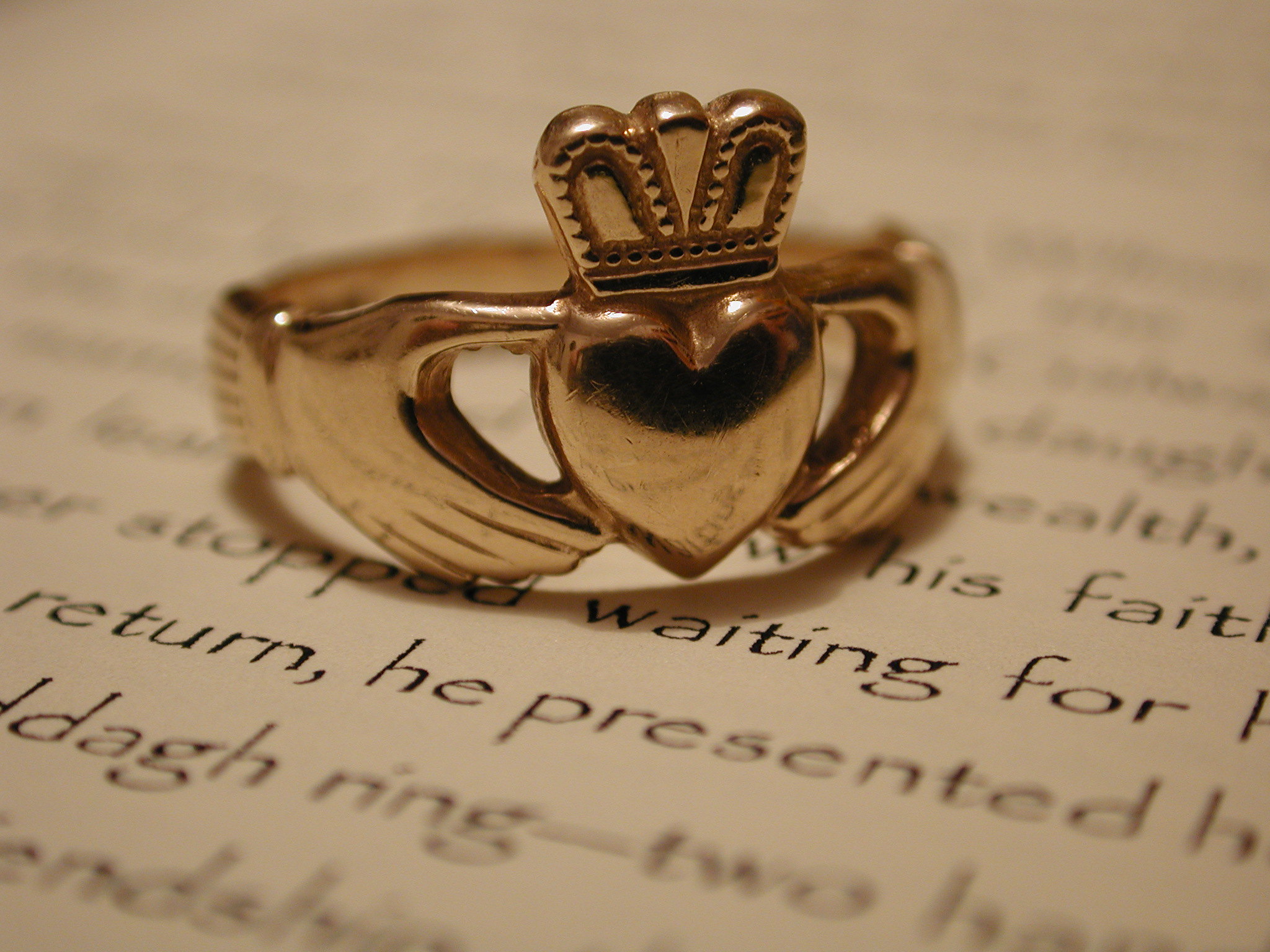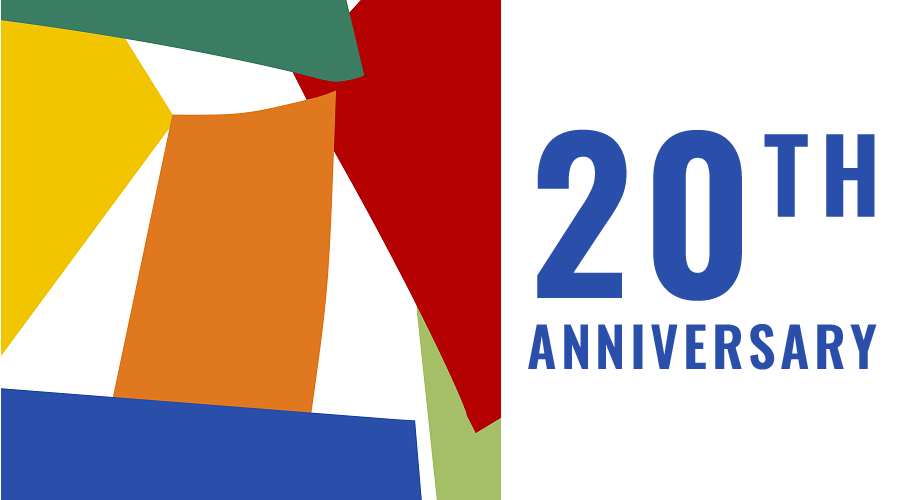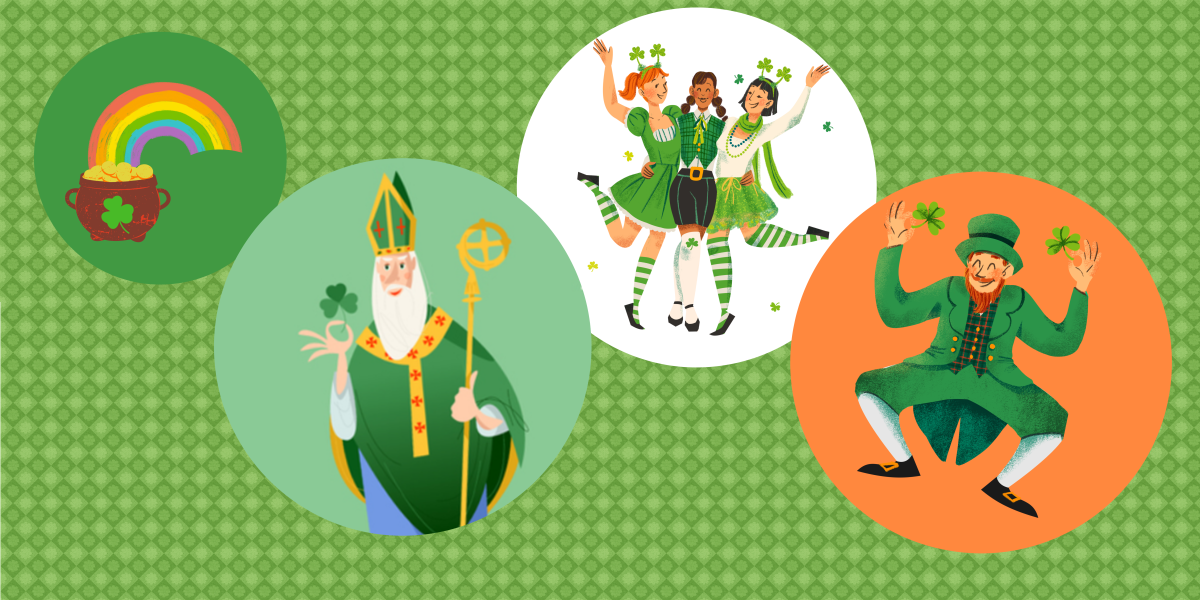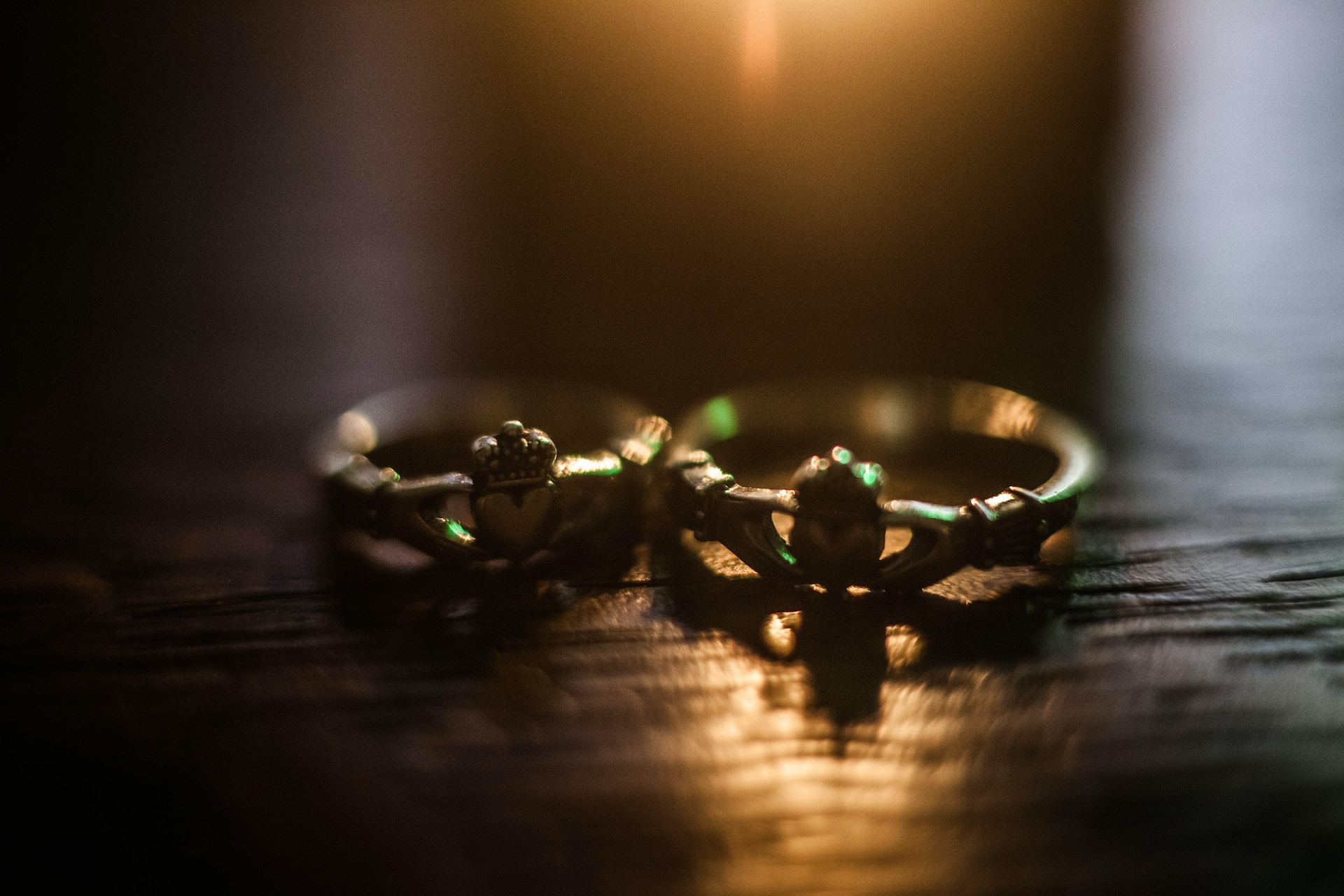CONCURSO: ¿Qué imagen utilizaría San Patricio en sus redes sociales?
El próximo 17 de marzo se celebra el Día de San Patricio, patrón de Irlanda. Aunque es una festividad de origen religioso, ya que conmemora la llegada del cristianismo a Irlanda, se ha convertido en una celebración cultural y social muy importante tanto en Irlanda como en el resto del mundo.
El Día de San Patricio se celebra en muchas ciudades con desfiles, festivales, conciertos, ferias y eventos deportivos. Las ciudades y pueblos se decoran con los colores nacionales de Irlanda: verde, blanco y naranja. Las personas suelen vestirse con prendas verdes y muchos adornan sus rostros con tréboles, símbolo asociado con San Patricio y con Irlanda en general.
Desde LAI queremos conmemorar el Día de San Patricio con un concurso. Te dejamos a continuación toda la información al respecto ¡Anímate a participar y llévate nuestros premios!
REQUISITOS Y OBJETIVOS DEL CONCURSO
• Estar cursando 1º, 2º, 3º o 4º de ESO.
• Crear una imagen para el perfil de San Patricio en redes sociales.
• En la imagen debe aparecer alguno de los símbolos característicos de San Patricio.
PASOS A SEGUIR
• Descarga y rellena la solicitud de inscripción y la autorización para el tratamiento de datos.
• Envía la documentación junto con tu imagen a info@lai.es antes de las 14h del día 14 de marzo.
• El día 19 de marzo se comunicará el ganador del concurso por correo electrónico.
PREMIO
El ganador se llevará una sudadera de San Patricio, un par de divertidos calcetines irlandeses, ¡y algunas sorpresas más!
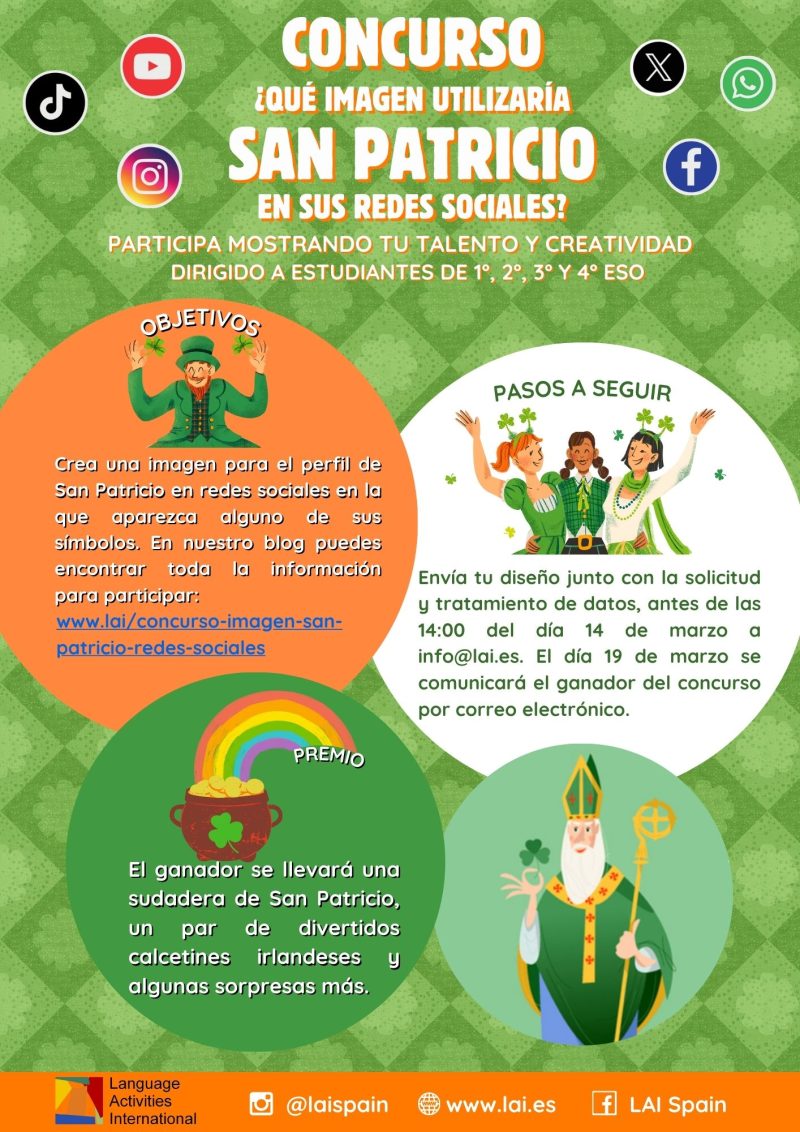
¿QUIÉN FUE SAN PATRICIO?
Para situar a San Patricio (conocido coloquialmente como “Sanpa”) en las redes sociales disponemos de múltiples referencias. Vamos a enumerar algunas de ellas que pueden servir de inspiración para el concurso que proponemos.
Nació aproximadamente 385 en Britania (Hoy Reino Unido). A los 16 años fue raptado y llevado a Irlanda como esclavo. Después de 6 años de cautiverio consiguió escapar y permaneció en Europa hasta el 432. En esta fecha regresa a Irlanda como misionero del cristianismo. Muere el 17 de marzo de 461. A partir de aquí comienza su leyenda.
En internet veréis que en la mayoría de las imágenes porta una seria vestimenta de Obispo con su casulla, estola, mitra (en algunas se reemplaza por un gorro singular) y un báculo o bastón (a veces enlazado con una serpiente). Se le atribuyen objetos como una campana (para llamar a oración), un escudo (para defenderse), un libro, una cruz y sobre todo un trébol (para explicar la Trinidad y hoy en día símbolo de Irlanda).
Antes de alcanzar el obispado fue un humilde monje del siglo V que recorrió a pie toda la isla de Irlanda. Nos lo imaginamos con un atuendo más práctico caminado con determinación por ese húmedo país. ¿Qué hacía? Ofrecer otras creencias (las cristianas) a los pobladores de la isla, más escorados hacia el paganismo. Nunca utilizó la violencia, ni amenazó con el temido fuego del infierno sino que sus armas fueron la persuasión y la concordia.
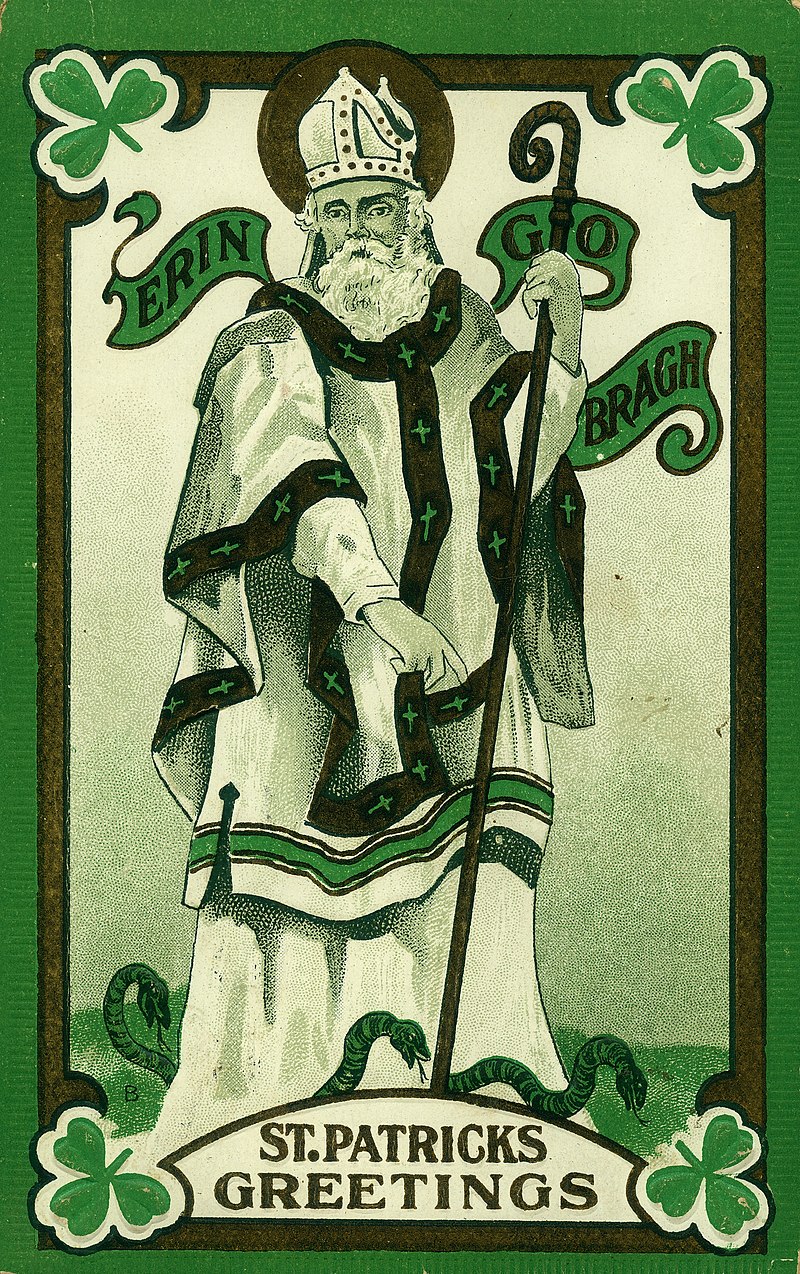
HISTORIAS Y LEYENDAS
A Sanpa se le atribuyen algunos milagros típicos de todos los santos (curar enfermos, etc.). Se le asigna también la inexistencia de serpientes en Irlanda pues se dice que las expulsó (aunque diversos documentos señalan que antes de su llegada no había tales serpientes).
Sin embargo, el principal milagro fue el de la amabilidad. Una multitud de peregrinos subía por el hoy conocido “Monte de San Patricio” (Croagh Patrick) con la intención de escuchar sus palabras. Era una mañana gris y una fina lluvia opacaba el paisaje. La plegaria de Sanpa hizo caer desde el cielo miles de capas impermeables que permitieron a cada uno de los fieles resguardarse, sentirse mejor, ascender más aliviados y escuchar las palabras de Sanpa con más atención y confort.
Y quizás por este hecho u otros semejantes, recordamos la amabilidad y hospitalidad de los irlandeses y alcanzamos entonces a celebrar el 17 de marzo de un modo distendido, alegre y sin ningún tipo de ideologías contrapuestas.

17 DE MARZO, DÍA NACIONAL DE IRLANDA
Se conmemora en toda Irlanda pero también de manera abrumadora en Nueva York, Chicago, Sídney, y en muchas otras ciudades del mundo donde la población irlandesa es abundante. También en España, donde se iluminan de verde algunos de los edificios históricos más significativos.
Es habitual que muchas personas lleven en su atuendo distintivos verdes, sombrero de Leprechaun, bandera de Irlanda, objetos con el trébol irlandés, etc.
¿Por qué una fiesta Nacional de un pequeño país está tan extendida por todo el mundo? Pues porque carece del carácter patriótico tradicional de este tipo de efemérides ya que no celebra ninguna victoria militar contra un país extranjero o contra una religión adversa.
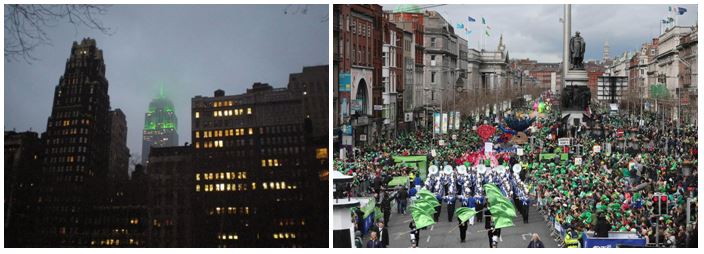
Es una fiesta alegre de desfiles extraordinarios y divertidos, música popular, donde las personas se reúnen para comer, beber, bailar, cantar y conversar.
Coincide además con el inicio de la primavera, estación plena de vida y luz que arroja afuera los duros y lastimosos días del invierno.
Es entonces, una fiesta de todos, para todo el mundo.
The Irish Claddagh Ring: Meaning, Origin and Symbol
The Claddagh ring (Irish: fáinne Chladaigh) is a traditional Irish ring that represents Love, Loyalty and Friendship – the heart represents Love, the crown represents Loyalty, and the hands represent Friendship. Its use has spread beyond the gaelic country. We will tell you now all you need to know about this very special piece of jewelry.
The first Claddagh ring appeared in the 17th century and is named after a coastal village of the same name located in Galway. Precisely, the word Claddagh is an English adaptation of Gaelic Cladach which means “seashore”.
The story of Richard Joyce
There are several stories about its origin, some more fanciful than others, but Richard Joyce’s is the most accepted, among other things, because the oldest Claddagh rings found have the initials RJ engraved on them, which would indicate that Joyce was the one who made them.
In the Galway area at the end of the 17th century, many families made a living from fishing and working at sea. There lived Richard Joyce, a young man who was engaged to a woman he loved deeply. Shortly before his wedding, he was captured by pirates while fishing in the sea. They took him to Africa, far away from his native Ireland, and sold him into slavery in Algeria, where he became the property of a wealthy Moorish goldsmith. While working, the craftsman saw that Richard had a natural talent for working with metal and jewelry and decided to make him his apprentice. Over time, Richard Joyce became a master goldsmith, but although he learned more about his art every day, he could not forget the woman who remained in his home. Guided by that love, he began to save small pieces of gold left over from his labors. When he had enough, he designed the first Claddagh ring in the hope that he could give it to his beloved one day.
Fourteen years passed, until in 1689 King William made several agreements that led to the release of his enslaved vassals, including Richard Joyce.
After all the years he spent with him, his master had grown fond of him and did not want him to leave, so he offered him the possibility of not returning home, marrying his daughter and giving him half of his wealth.
However, Richard rejected the offer and returned to Galway.
When he finally arrived, he found his love, who had waited all these years for his return. Richard Joyce was able to make his dream come true and offered her the ring that he created when thinking of her and they finally got married.
Symbology and meaning of the Claddagh ring
Although the design of the ring has become a very representative figure of the Irish culture, not all of its features are unique to the island. The ring is reminiscent of the Phede wedding rings of the Romans, long before the creation of the Claddagh ring and whose use spread throughout Europe since the Middle Ages. These rings were usually shaped like hands intertwined to represent commitment and were exchanged between couples in love.
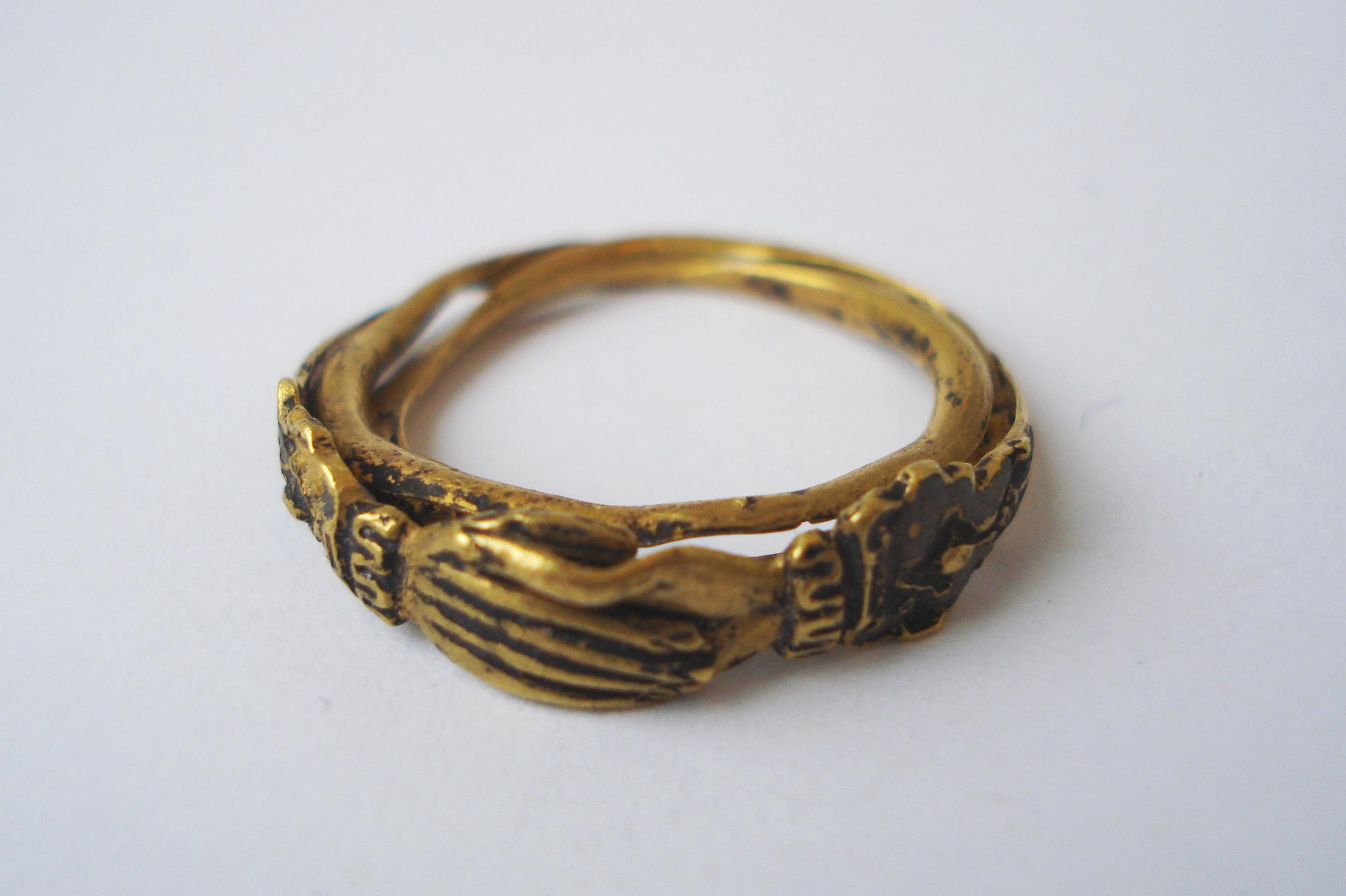
The ring is always made up of 3 elements:hands holding a crowned heart. However, it is possible that the ring also has Gaelic knots and braids, depending on the craftsman.
- The hands are intertwined and hold together the crowned heart, represent friendship.
- The heart is the centerpiece of the ring elements. It represents, of course, love.
- The crown is the symbol typically used to represent the royalty. Placed over the heart, it represents loyalty and fidelity.

All of them together represent the ring’s motto “Let Love and Friendship reign”, in Gaelic is “Grá, Dílseacht, Cairdeas” (pronounced “Graw, Deal-shocked, Core-jass”).
How to wear the Claddagh ring
Over the centuries, a large number of legends and traditions have been created around both the ring and its meanings, the most notable today being the different meanings it can have depending on how it is used.
The first thing you have to keep in mind is that, if you are not married, you should always carry it in your right hand. The meaning will be more specific depending on the position of the ring:
- If you carry it in your right hand with the tip of the heart pointing away of your body, it means you don’t have a partner.
- If you carry it in your right hand with the tip of the heart pointing towards your body, it means that your heart is busy and you have a partner.
- If you carry it in your left hand with the tip of the heart pointing away of your body, it means you are engaged.
- If you carry it in your left hand with the tip of the hand pointing towards your body, it means that you are married.
Curiosities and questions about the Claddagh ring
It doesn’t matter what finger you use it on
The meaning of the Claddagh ring does not change depending on which finger you wear it on, it only affects the hand. For example, Walt Disney is one of the famous people who has been recognized for wearing this ring and yet, he wore it without following tradition. What’s more, it was said that even though he was married, he wore it pointing away from his body, this story was so widespread that the ring can be seen on the statue in his memory erected at DisneyWorld.
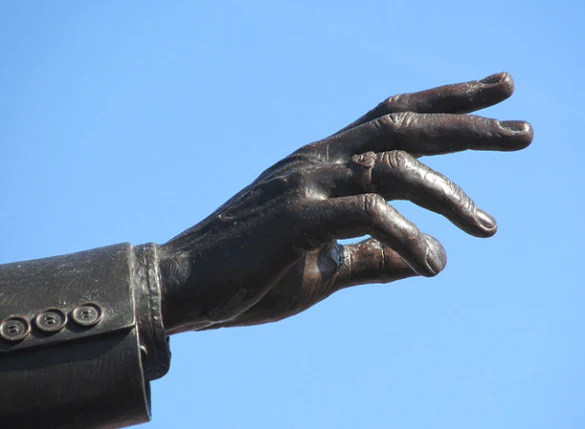
Being single doesn’t matter
Precisely one of the ways to use the Claddagh ring is to express that you do not have a partner, it is not only used by married people or people in relationships.
A ring for everyone
Whether you are a man, woman, teenager, child… no matter your gender or age, the tradition of the Claddagh ring has no ifs and buts to be worn by anyone.
It may have religious meaning
Ireland is a country whose history has been closely linked with Christianity. The 3-leaf clover itself, the shamrock, has a story about how St Patrick used it to explain the holy trinity and the triquetra was reinterpreted with the same meaning by Christians. Something similar happens with the Claddagh ring: it can be determined that the 3 elements represent the holy trinity, in some cases going so far as to adapt the design with a crown of thorns.
What intention does someone have if they give me a Claddagh ring?
It totally depends on the relationship between those people, since the ring not only symbolizes a romantic relationship. The heart, hands and crown all symbolize positive affections, bonds and long-lasting relationships, so there is no problem with giving it as a gift between family and friends.

If you’re not Irish… It’s okay
The tradition of wearing the Claddagh ring has traveled beyond the Gaelic island. Whether because they have Irish ancestors and want to use it as an inheritance, because of the symbolism of the pieces or because of their beauty, its use has spread to multiple parts of the world.
Since the meaning that the ring may have only indicates the status of the person who wears it, it does not matter if it is given to you as a gift or if you buy it yourself.
However, although it has a well-known tradition, these rules and curiosities are not strict rules, since the most important thing about the Claddagh ring is its message of affection and bond that the ring represents.
So, don’t hesitate and enjoy this piece of Irish tradition.
